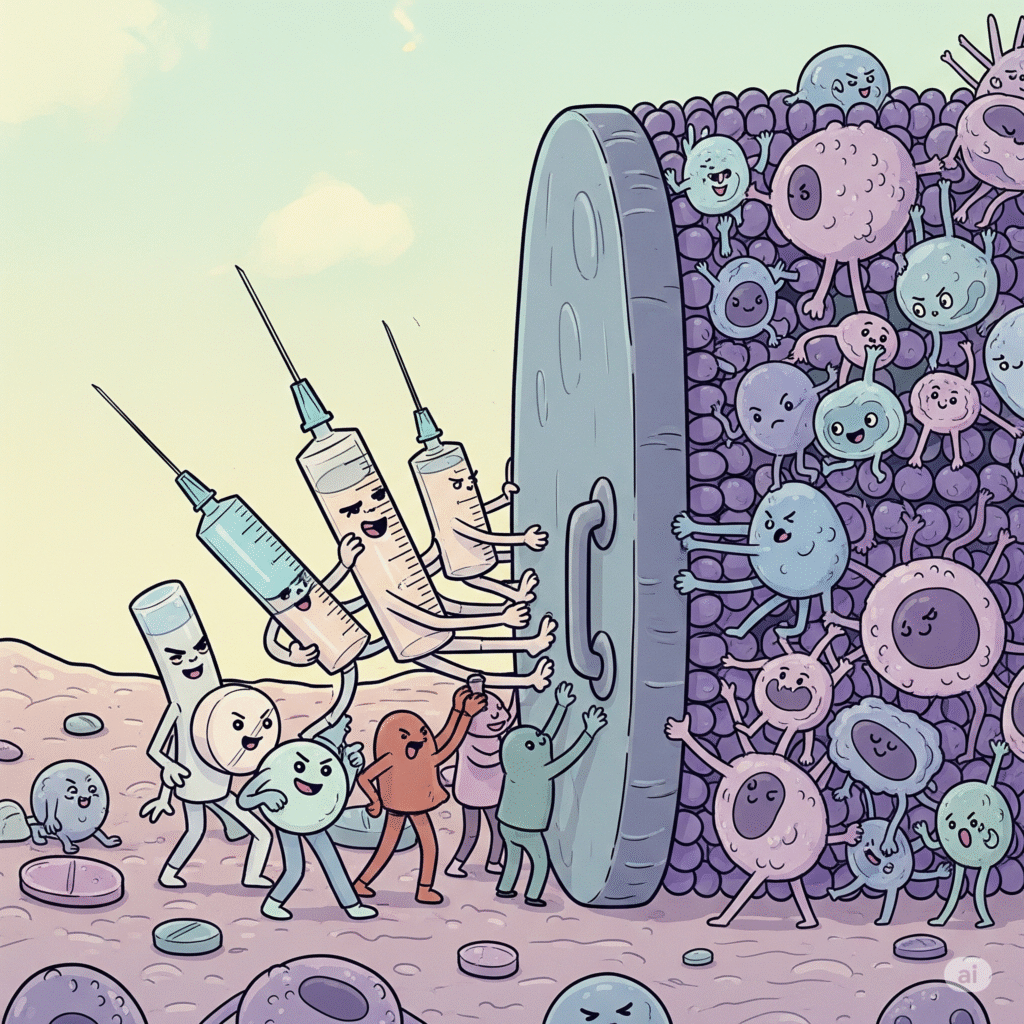Imagine your body as a vast city, its power plants (cells) burning fuel (glucose) to keep everything running. Now imagine that many of those power plants have “worn-out” machinery—leaky, rusty gears that jam and spark.
It is easy to imagine that forcing more fuel into this power plant can lead to an explosion.
This is exactly the story of Glitazones- Rosiglitazone and Pioglitazone, which force glucose from blood into the cells- thus reducing blood sugar level- but at the expense of long-term safety.
Note: You will find a few phrases/words in every section hyperlinked in orangish color. These hyperlinks lead to the references, in case you want to verify and do some research on your own!
Table of Contents
Historical Sidebar: Billion-Dollar Blockbusters with a Dark Side
Rosiglitazone was discovered in the early 1990s and approved by the FDA in 1999 under the brand name Avandia. It quickly became a blockbuster, with global sales peaking at over $3 billion per year in the mid-2000s.
Pioglitazone, followed a similar trajectory. Approved in 1999, it soon became one of the top-selling diabetes drugs globally, with annual revenues exceeding $4 billion before safety concerns surfaced.
Both drugs were once hailed as revolutionary tools to combat insulin resistance. But behind their commercial success lay a hidden danger that would reshape diabetes treatment protocols forever.
The Paradox of Insulin Resistance
Most of us were taught that insulin resistance (IR) is bad: when IR develops, cells refuse the key (insulin) that unlocks their fuel doors (glucose transporters), leading to high blood sugar. But imagine a damaged power plant. Adding more coal to a broken boiler only creates more smoke, more soot, and eventually can lead a blazing inferno that can engulf the entire set-up. IR acts like a safety valve, limiting fuel entry when the machinery is compromised by inflammation and energy-production defects.
Key point for non‑biologists: Cells make energy in tiny factories called mitochondria. If those factories are already broken, feeding them extra sugar creates toxic byproducts, much like overloading an old engine creates engine knocking and breakdown.

The Glitazones: Rosiglitazone and Pioglitazone
The two drugs at the heart of our story- Rosiglitazone and Pioglitazone- belong to a class of drugs called Thiazolidinediones (TZDs), also sometimes called Glitazones. These names—Thiazolidinediones, Rosiglitazone, Pioglitazone—sound complicated, but their effect is simple to understand. In patients with type 2 diabetes mellitus (which we commonly call as “diabetes”), cells shut down their doors to glucose. This is known as insulin resistance (IR). Because of IR, the glucose has nowhere else to go and hence simply starts accumulating in blood. This is why in diabetics we see high blood sugar levels. As I explained earlier, IR is a protective mechanism- it is a safety valve. Glitazones essentially remove the safety valve of insulin resistance (IR), forcing the cells to take in more glucose.
To go a bit technical on this- Glitazones turn on a controller called PPAR‑γ, which lives in each cell’s nucleus. Once PPAR‑γ is active, it orders the production of more glucose doors (transporters) on the cell surface.
Cells suddenly witness massive influx of glucose, thus quickly lowering blood sugar.
From a doctor’s perspective this effect is amazing- in diabetes we want blood sugar to come down.
But in reality, what a Glitazone does, is harmful. It forces the broken power turbines to generate power from the fuel (glucose). The result is generation of immense amount of inflammation which ends up in damaging heart and other organ systems.
Heart Failure with Rosiglitazone
Shortly after its launch, reports of fluid retention and edema raised concerns about heart failure risk, prompting the FDA to add precautionary labeling by 2002. The controversy intensified in 2007 when Dr. Steven Nissen’s meta-analysis suggested increased heart attack risk, generating widespread alarm. However, the definitive evidence came from the dedicated RECORD trial, which in 2009 revealed a doubled risk of heart failure hospitalizations or death—a finding that couldn’t be disputed. This led to severe regulatory restrictions, including FDA black box warnings and European market suspension by 2010. While some restrictions were later eased in 2013 after reassessment of heart attack risks, the heart failure danger remained consistent across all studies, with a 2020 meta-analysis confirming a 54% increased risk.
The Cancer Connection: Pioglitazone and Bladder Cancer Risk
The association between pioglitazone and bladder cancer emerged from early animal studies showing bladder tumors in male rats, followed by a concerning signal in the PROactive cardiovascular trial where 14 bladder cancer cases occurred in the pioglitazone group versus 6 in placebo. This prompted large-scale observational studies, most notably from Kaiser Permanente Northern California, which found increased bladder cancer risk particularly with longer duration use (24+ months). Despite mixed findings across studies, the consistent pattern of increased risk with duration and dose led to significant regulatory action: the FDA mandated bladder cancer warnings on pioglitazone labels in 2011, while France and Germany suspended its marketing authorization entirely. Unlike the clear-cut rosiglitazone-heart failure link, the pioglitazone-bladder cancer association remains more debated, with subsequent meta-analyses generally supporting a small but real increased risk, making it a drug-specific effect within the TZD class that continues to warrant ongoing monitoring and caution in clinical practice.
Beware of Insulin Injections and Sulphonylureas as well
This is one opinion on which I have been facing severe criticisms since more than a decade. Unfortunately, my opinion continues to be the unpopular one. I personally think insulin injections and Sulphonylureas (eg, Glibenclemide, Glipizide, Glimiperide etc) are as bad as Glitazones. If forcing glucose into damaged cells with TZDs poses long‑term risks, consider insulin injections and Sulphonylureas —they are the most direct way to open fuel doors. Injecting insulin or taking Sulphonylureas forces open the doors that cells had closed against sugar. Blood sugar drops rapidly- both with insulin and Sulphonylureas – more rapidly than any other known agent. But my concern here is exactly what I have against TZDs. Excess glucose in cells with defective metabolic machinery accelerates inflammation, and tissue damage—just like TZDs.

I have written a detailed article why (in my opinion) insulin and Sulphonylureas should be avoided. Do have a look. Here is the LINK to that article.
Any medication that triggers inflammation nudges the body to gain weight.
Note that all the these medicines I discussed- Glitazones, insulin, Sulphonylureas- share a common outcome: all cause patients to gain weight.
Safer Paths
As a doctor who has been treating diabetes since more than a decade, I personally like using Metformin and SGLT2is.
Unlike TZDs, insulin or Sulphonylureas, Metformin tackles the root cause: inflammation.
Metformin activates AMPK, a cellular energy sensor that reduces inflammatory pathways.
It improves mitochondrial efficiency, cutting ROS production. It also lowers insulin levels, which further decreases inflammatory signaling. The result is better blood sugar control without forcing cells into dangerous overdrive. And Metformin causes weight loss, and has been shown to be cardio-protective.
SGLT2is like dapagliflozin, canagliflozin and empagliflozin have a unique and interesting mechanism. They flush out excess sugar out of body via urine, thus lowering the blood sugar level.
Studies have conclusively shown that SGLT2is offer cardiovascular benefits and lead to weight loss.
Please do not misundertand me- I do think that Insulin, Pioglitazone and Sulphonylureas have role to play in management of diabetes; but only in extreme cases for a limited period of time. If the blood sugar levels are way too high use these drugs to bring the sugar levels under control. But I won’t use these drugs continuously for a long time. Ofcourse, this is my personal opinion.
Inflammation is the spark beneath diabetes’s flame. Don’t pour fuel on the fire—choose treatments that douse it.





